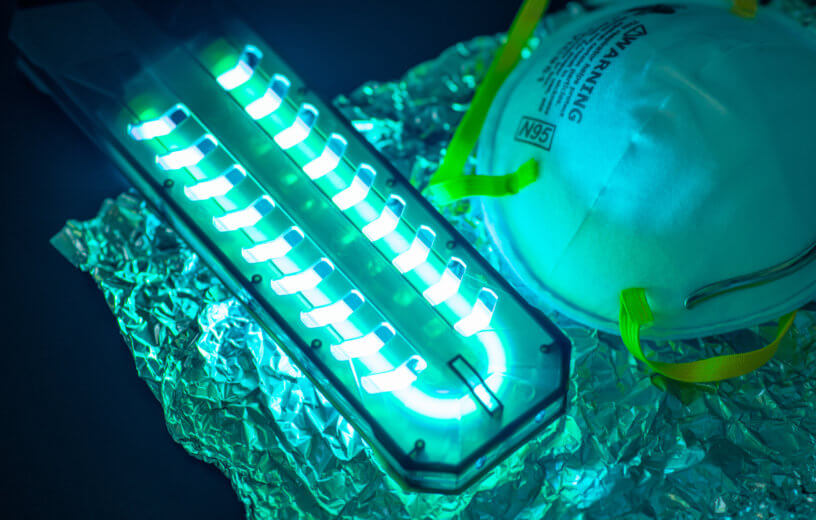TORONTO, Ontario — Could ultraviolet light wipe out HIV with the flip of a switch? A new study reveals UV-LED lights have the ability to not only destroy various strains of coronavirus, but also eliminate HIV.
Christina Guzzo from the University of Toronto Scarborough says UV-LED lights alternate between white light and virus-decontaminating ultraviolet (UV) light. They could fit into standard lighting fixtures, creating a “unique appeal” for health officials looking to disinfecting public spaces.
“We’re at a critical time where we need to use every single possible stop to get us out of this pandemic,” says Guzzo, an assistant professor in the department of biological sciences, in a university release. “Every mitigation strategy that can be easily implemented should be used.”
How does UV light kill viruses?
The process is very simple, radiation from UV light destroys these cells. Researchers first tested the bulbs on bacterial spores which are highly resistant to this kind of radiation — Bacillus pumilus.
“If you’re able to kill these spores, then you can reasonably say you should be able to kill most other viruses that you would commonly encounter in the environment,” Guzzo explains.
Results show that the growth of the hard-to-kill spores dropped off by 99 percent within just 20 seconds of UV exposure.
Following this successful test, the team created droplets containing either coronavirus or HIV. Researchers say these droplets mimic the way people could possibly encounter both viruses in the real world, through blood or, in the case of COVID-19, through coughing or sneezing.
After just 30 seconds of UV light exposure, each virus’s ability to infect people dropped by 93 percent. Even in cases where the concentration of virus particles was extremely high, Guzzo says the “the worst-case scenario” still lowered virus infectivity by a staggering 88 percent. UV light also produced similar results to two heavy duty disinfectants scientists use in laboratory experiments.
“I was really surprised that UV could perform on the same level of those commonly used lab chemicals, which we regard as the gold standard,” the study author says. “That made me think, ‘Oh, my gosh, this is a legitimate tool that’s really underutilized.’”
Using the ‘Swiss cheese’ defense against viruses
Although these lights leave a very small amount of the virus alive, Guzzo says this still adds another layer to the “Swiss cheese model” of defense against viruses like COVID-19. This concept states that even if one strategy doesn’t completely eliminate a virus, every extra layer has a chance to catch surviving particles.
Study authors add that using UV light and changing light bulbs is simpler than converting an entire air filtration system or scrubbing a room clean by hand. These lights are cheap, long-lasting, and relatively easy to maintain.
“You could disinfect in a way that wouldn’t be infringing on people’s enjoyment of that everyday ‘normal’ life that they long for,” Guzzo says.
UV light is not completely harmless
Unfortunately, using UV-LEDs is not a completely safe plan. Study authors note that long-term exposure to UV light damages human cells. That’s one of the main reasons it’s important to wear sunscreen when outside.
A solution to this, Guzzo says, is to switch on UV lights when public spaces are empty. One example of this would be using UV light in buses after they complete their routes and all the passengers have left.
“Worldwide events like the COVID-19 pandemic, as terrible as they are, hopefully can still be learned from,” Guzzo concludes. “One thing we learned is that this is an underutilized tool we should think more about implementing.”
The study is published in the Virology Journal.


If it only takes 30 seconds to disinfect maybe you could do it a couple times an hour in an occupied room. That’s not much exposure, I’d think. We don’t put on sunscreen every time we go to check the mail, for example.
How about a UV light that comes on periodically when no one is in the room? It couldn’t just be a reverse motion detector because you wouldn’t want a stationary person (possibly sleeping) to be exposed.
UV-C radiation is very dangerous and not practical for use outside of controlled environments like laboratories, hospitals, sewage treatment plants, etc…
Yes, AND it will only disinfect areas actually touched by the light. Example would be any 3 D object where light touches the top surface, but not the rest. Light would have to stream from multiple angles. Anything not touched would still be contaminated.
I see this as a tool, but part of an arsenal and not for generalized usage.
There are certain skin conditions that can be treated with UV radiation. With modern phototherapy, successful treatment of eczema, dermatitis, rickets, atopic and localized scleroderma, jaundice, psoriasis, and vitiligo is now possible.